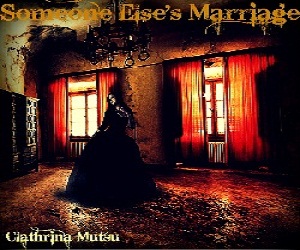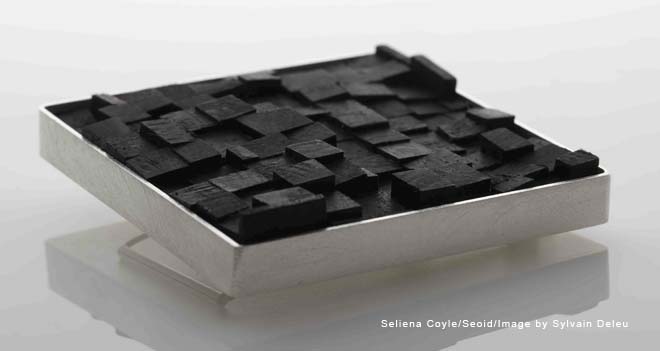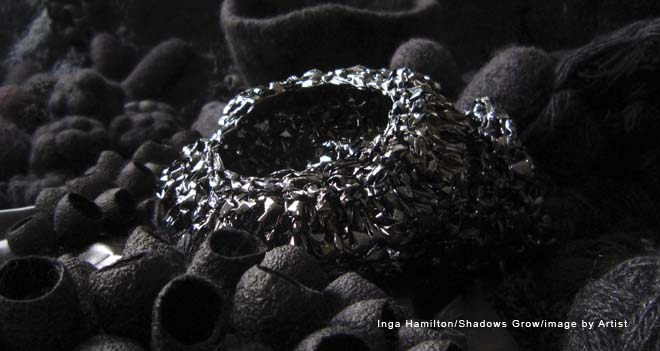In an era of virtual reality the prospect of visiting an exhibition dedicated to products of designer craft presents a salutary experience. Here, at least, one can be assured of an encounter with the visual imagination made tangible; ideas translated into something that can be touched, held, worn, or reclined upon. The exhibition DUBH – Dialogues in Black, is an eye and mind-opening example of what contemporary designers are thinking about and actualizing at the cutting edge of our engagement with material culture.
Stemming from an initiative developed by Irish craftsman Joseph Walsh’s organization, STUDIO practice, and curated by Irish artist Brian Kennedy, the premise of the show is to place contemporary Irish craft and design practitioners in concert with their U.S. and international peers, demonstrating the vitality of Irish designers and drawing attention to the greater innovative achievements current in contemporary craft and design practice. You can put away your fusty expectations of finding the traditional crafts associated with Ireland – Aran sweaters, bawneen knits, country pottery, Donegal tweeds – and prepare to embark on a distinctly twenty-first century experience. Most of the craftspeople here seem to be considering contemporary notions of biology, genetics, even particle physics, disposing of historical attitudes toward craft practice, or confronting good old fashioned cultural myopia. “Dialogues in Black” may be the organizing principle behind this collection (dubh – pronounced duv – is the Irish for black) but the range of forms, feelings, and ideas at play here presents quite a varied sampling of treasures. Kennedy appears to have reached wide and far, and he is to be commended for both the breadth of the show and for permitting the “dialogue” that occurs to flow so sleekly about the gracious and somewhat period styled interiors of the AIHS’s rooms. An artful balance is struck, never permitting any exhibitor’s contribution a domineering presence or freer rein than the others. He knows how to show this stuff.
The “stuff” extends from Inga Hamilton’s floor lying fabric installation – an inky puddle of joined textiles with scattered ceramic bone pieces and marabou feather trim, lurking beneath a grand piano like a fugitive shadow – through Liam Flynn’s exquisite and commanding ebonized turned wood vessels, to Catherine Owens’s slow-blooming graphite and light drawings silently holding a wall in one corner. Undeniable they may be, but Jonathan Wahl’s poster sized, photo-realistic charcoal drawings, detailing pieces of Victorian jet mourning jewelry on stark white backgrounds, retain rigor and self-discipline for all their scale, and seem to turn their volume down enticingly as they lure you closer to inspect them. You can’t miss Joseph Walsh’s Enignum II chair either, poised on three legs, somewhat resembling a curlew, as Walsh works characteristically to bend wood almost as if it were wax. Restrainedly zoomorphic, it is echoed by Frances Lambe’s ravishing ceramic pieces – Sea Bean and Spiny Form – which resemble fantasies by Ernst Haeckel , and by Sonya Clark’s cunning and thoughtful tick piece, rendered in a construction of plastic combs. The vegetable realm gets a graphic homage in a paper construction by Lauren Fensterstock, in jewelry by Eily O’Connor, and even in the zipper jewelry of Kate Cusack whose mature visualization using this singularly mundane product is as excitingly innovative as it is impressive. Nuala O’Donovan’s complex, architectural porcelain grid cube is concerned with fractals and organic patterning, and there’s more than a whiff of micro-organisms about the jewelry works of Sondra Sherman and Douglas Bucci. Bucci’s arresting work in particular derives from microbe and cell forms, digitally rendered and tweaked in graphic form and then given substance using a three dimensional “printing” process. This is frontline digital industrial technology, and Bucci is not the only designer deploying it here. Catherine Owens’s drawings are housed in frames made with a similar replicating process, and combined with her painstaking, laborious graphic handiwork, they couple traditional hand craftsmanship with contemporary authorial digital design. Bucci’s work is all but exclusively designed in virtual space, and then produced using a resinous compound from a three-dimensional printer reading. If we are getting to the point where the craftsman’s hands may never touch a work until it is actually “finished”, can we still call it craft? For brevity’s sake let’s dodge that one and just refer to these craftspeople – gifted designers, visionary creators – as artists. In our times that’s a somewhat hackneyed, more than a little bloated term, and without wishing to be too controversial I might even suggest that they would breathe a little more authenticity into it. In total there are thirty such exhibitors in this highly recommended show, and I for one would not begrudge any of them the title.
The show runs through November 13th and will travel to Dublin next year. Anyone interested in design will find something to admire here, and everyone wondering where – culturally, aesthetically – we are right now, will find much to ponder on and not a little to delight in.
~~~
dubh – dialogues in black New York 7 October – 13 November 2011 An exhibition of contemporary objects, featuring work by Irish designers and artists in dialogue with their American peers. OPEN Thursday – Sunday, 10-5 American Irish Historical SocietyAmerican Irish Historical Society 991 Fifth Avenue New York, NY 10028





{ 0 comments… add one now }